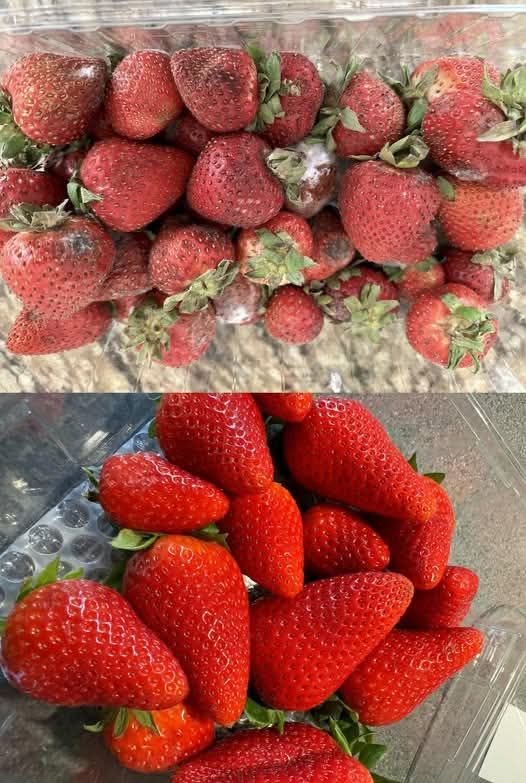Source: University of California, Riverside / Getty Images
In my humble opinion, strawberries are one of the most delicious fruits in existence. Their vibrant red color, sweet taste, and juicy texture are a combination that can hardly be beaten. Whether they’re eaten fresh, blended into smoothies, or added to a salad, strawberries add a burst of flavor to any dish. However, one downside to strawberries is how difficult they are to keep fresh. It feels like 24 hours after you bring them home, they become mushy, shriveled, and covered in mold. This can be quite frustrating, especially since strawberries are not the cheapest fruit out there. It’s a real shame to spend money on something that quickly turns into a slimy, inedible mess before you have a chance to enjoy them fully.
The good news is that there are ways to extend the shelf life of strawberries and keep them fresh for a longer period. By following a few simple tricks, you can preserve their flavor, texture, and appearance for days longer than you might expect. So, what’s the solution to this problem? The key lies in how you handle and store your strawberries after purchasing them.
The Vinegar Solution:
Source: Marches Publics de Montreal
When it comes to preserving fresh strawberries, vinegar is your secret weapon. Vinegar is not just for cleaning your kitchen or dressing your salad – it also helps to keep fruits fresh, especially strawberries. You may be surprised to learn that vinegar can play a significant role in keeping your berries free from mold and bacteria.
To start, grab a bowl and mix a splash of white vinegar with some water. This solution will help to eliminate the mold spores on the strawberries that are responsible for causing them to spoil so quickly. Soaking strawberries in this vinegar-water mixture for a few minutes will help to kill off the spores that trigger the growth of mold. In fact, studies have shown that the acidity in vinegar can effectively kill bacteria and fungi, thus preventing spoilage. Not only does this process prolong the freshness of the strawberries, but it also keeps them safer to eat.
Simply immerse the strawberries in the vinegar-water solution for about five minutes. You’ll notice that it’s an easy step that doesn’t require a lot of time or effort. After the soaking period, gently remove the strawberries from the solution and place them on a clean paper towel or a drying rack. You’ll want to make sure they’re thoroughly dried before proceeding to the next step.
Proper Drying and Handling:
Source: Treehugger / Flickr
Once you’ve soaked the strawberries in the vinegar solution, it’s crucial to dry them properly. The moisture left on the strawberries after washing can cause mold and bacteria to grow more quickly, which will defeat the purpose of the vinegar soak in the first place. So, take a paper towel and gently pat each strawberry to remove any excess moisture. This step is important, as damp strawberries are more prone to spoilage.
Now that the strawberries are clean and dry, don’t put them back in the same container you bought them in. Most store-bought strawberry containers are designed to hold the berries for just a few days, and they tend to trap moisture, which creates the perfect environment for mold to grow. Instead, place the dried strawberries on a fresh paper towel, and transfer them into a clean, dry container. A ventilated container or a shallow container with a lid is best for this purpose. You could also opt for a special produce keeper designed to allow airflow, which helps extend the shelf life of fresh fruits and vegetables.
The Right Storage Conditions:
When storing your strawberries, temperature plays a critical role in how long they stay fresh. Many people make the mistake of leaving their strawberries out on the kitchen counter or in the fruit bowl. However, this is not ideal, as the warmer temperatures encourage mold growth and quick spoilage. The best place to store your strawberries after cleaning and drying them is in the refrigerator.
Place the container with your fresh strawberries in the fridge, but make sure it’s on a shelf that isn’t too close to the back wall, where it’s typically the coldest. Freezing temperatures can damage the berries and cause them to become mushy once thawed. The ideal temperature for strawberries is between 35-40°F (1.5-4.5°C). Storing them in the crisper drawer of your fridge may be a good option, as it maintains a more consistent temperature and humidity level.
Additional Tips to Keep Strawberries Fresh:
While soaking your strawberries in a vinegar-water solution and storing them properly in the fridge will significantly extend their freshness, there are a few other strategies you can use to ensure they stay good for as long as possible.
- Avoid Washing Until Ready to Eat:
One of the key mistakes people make when storing strawberries is washing them before putting them away. While it may seem logical to wash them right after purchasing, moisture can speed up the decay process. Instead, try to avoid washing strawberries until just before you’re ready to enjoy them. This will help them retain their freshness longer. - Remove Damaged Berries:
Before storing your strawberries, it’s essential to inspect them carefully for any damaged, overripe, or moldy berries. One spoiled berry can quickly affect the rest of the batch and accelerate the mold growth process. Gently remove any berries that show signs of damage to prevent them from ruining the entire batch. - Use Paper Towels to Absorb Moisture:
In addition to drying your strawberries thoroughly after washing them, you can also line the storage container with a layer of paper towels. The paper towels will absorb any moisture that accumulates in the container, keeping the strawberries drier and less prone to mold. Be sure to replace the paper towels if they become too damp over time. - Consider Freezing for Long-Term Storage:
If you find that you have a surplus of strawberries that you can’t consume before they spoil, consider freezing them for later use. To freeze strawberries, wash and hull them first, then place them on a baking sheet in a single layer to freeze. Once frozen solid, transfer them to an airtight freezer bag or container. Frozen strawberries are great for smoothies, desserts, or baking, though they may lose some of their texture once thawed. - Use a Produce Saver:
There are various produce-saving gadgets on the market designed to help prolong the shelf life of fruits and vegetables. These products generally work by absorbing ethylene gas, a natural compound produced by many fruits that speeds up ripening and spoilage. Consider investing in a strawberry-specific produce saver to create an ideal environment for your berries.
Conclusion:
Keeping strawberries fresh for as long as possible doesn’t have to be difficult or expensive. By using a simple vinegar solution to kill mold spores and bacteria, properly drying the berries, and storing them in a clean container in the fridge, you can enjoy your strawberries for days after purchasing them. With a little care and attention, your strawberries can stay fresh, juicy, and delicious, allowing you to enjoy them without worrying about spoilage or waste. So next time you bring home a pint of these sweet treats, try out these methods and savor every bite while keeping your strawberries fresh for longer!




